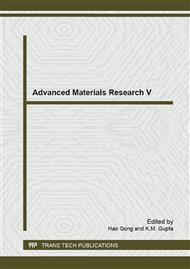[1]
S. Cahangirov, M. Topsakal, E. Aktürk, H. Şahin, and S. Ciraci: Two- and one-dimensional honeycomb structures of silicon and germanium. Phys. Rev. Lett. Vol. 102 (2009) 236804.
DOI: 10.1103/physrevlett.102.236804
Google Scholar
[2]
C. -C. Liu, W. Feng, and Y. Yao: Quantum spin hall effect in silicene and two-dimensional germanium. Phys. Rev. Lett. Vol. 107 (2011) 076802.
DOI: 10.1103/physrevlett.107.076802
Google Scholar
[3]
Z. Ni, H. Zhong, X. Jiang, R. Quhe, G. Luo, Y. Wang, M. Ye, J. Yang, J. Shi, and J. Lu: Tunable band gap and doping type in silicene by surface adsorption: towards tunneling transistors. Nanoscale Vol. 6 (2014) 7609.
DOI: 10.1039/c4nr00028e
Google Scholar
[4]
R. Quhe, R. Fei, Q. Liu, J. Zheng, H. Li, C. Xu, Z. Ni, Y. Wang, D. Yu, Z. Gao, and J. Lu: Tunable and sizable band gap in silicene by surface adsorption. Sci. Rep. Vol. 2 (2012) 853.
DOI: 10.1038/srep00853
Google Scholar
[5]
Z. Ni, Q. Liu, K. Tang, J. Zheng, J. Zhou, R. Qin, Z. Gao, D. Yu, and J. Lu: Tunable bandgap in silicene and germanene. Nano Lett. 12 (2012), p.113.
DOI: 10.1021/nl203065e
Google Scholar
[6]
H. Xie, M. Hu, and H. Bao: Thermal conductivity of silicene from first-principles. Appl. Phys. Lett. Vol. 104 (2014) 131906, p.1.
Google Scholar
[7]
X. Gu and R. Yang: First-principles prediction of phononic thermal conductivity of silicene: a comparison with graphene. ArXiv e-prints 1404. 2874 (2014).
Google Scholar
[8]
B. Liu, C.D. Reddy, J. Jiang, H. Zhu, J.A. Baimova, S.V. Dmitriev, and K. Zhou: Thermal conductivity of silicene nanosheets and the effect of isotopic doping. J. Phys. D: Appl. Phys. Vol. 47 (2014), p.1.
DOI: 10.1088/0022-3727/47/16/165301
Google Scholar
[9]
X. Zhang, H. Xie, M. Hu, H. Bao, S. Yue, G. Qin, and G. Su: Thermal conductivity of silicene calculated using an optimized Stillinger-Weber potential. Phys. Rev. B Vol. 89 (2014) 054310.
DOI: 10.1103/physrevb.89.054310
Google Scholar
[10]
T.Y. Ng, J. Yeo, and Z. Liu: Molecular dynamics simulation of the thermal conductivity of shorts strips of graphene and silicene: a comparative study. Int. J. Mech. Mater. Des. Vol. 9 (2013).
DOI: 10.1007/s10999-013-9215-0
Google Scholar
[11]
J.J. Yeo and Z.S. Liu: Molecular dynamics analysis of the thermal conductivity of graphene and silicene monolayers of different lengths. J. Comput. Theor. Nanosci. Vol. 11(8) (2014), p.1790.
DOI: 10.1166/jctn.2014.3568
Google Scholar
[12]
Q. -X. Pei, Y. -W. Zhang, Z. -D. Sha, and V.B. Shenoy: A theoretical analysis of the thermal conductivity of hydrogenated graphene. J. Appl. Phys. Vol. 114 (2013) 033526.
Google Scholar
[13]
M. Hu, X. Zhang, and D. Poulikakos: Anomalous thermal response of silicene to uniaxial stretching. Phys. Rev. B Vol. 87 (2013), p.195417.
DOI: 10.1103/physrevb.87.195417
Google Scholar
[14]
Q.X. Pei, Z.D. Sha, and Y.W. Zhang: A theoretical analysis of the thermal conductivity of hydrogenated graphene. Carbon Vol. 49 (2011), p.4752.
DOI: 10.1016/j.carbon.2011.06.083
Google Scholar
[15]
R. Pan, Z. Xu, Z. Zhu, and Z. Wang: Thermal conductivity of functionalized single-wall carbon nanotubes. Nanotech. Vol. 18 (2007) 285704.
DOI: 10.1088/0957-4484/18/28/285704
Google Scholar
[16]
N. Attaf, M.S. Aida, and L. Hadjeris: Thermal conductivity of hydrogenated amorphous silicon. Solid State Comm. Vol. 120 (2001) 525.
DOI: 10.1016/s0038-1098(01)00428-8
Google Scholar
[17]
H.P. Li and R.Q. Zhang: Anomalous effect of hydrogenation on phonon thermal conductivity in thin silicon nanowires. Europhys. Lett. Vol. 105 (2014), p.56003.
DOI: 10.1209/0295-5075/105/56003
Google Scholar
[18]
S. Plimpton: Fast parallel algorithms for short-range molecular dynamics. J. Comp. Phys. Vol. 117 (1995).
Google Scholar
[19]
F. Liu, C. -C. Liu, K. Wu, F. Yang, and Y. Yao: d+id' chiral superconductivity in bilayer silicene. Phys. Rev. Lett. Vol. 111 (2013) 066804, p.6.
Google Scholar
[20]
C. Kamal, A. Chakrabarti, A. Banerjee, and S.K. Deb: Silicene beyond mono-layers—different stacking configurations and their properties. J. Phys.: Condens. Matter Vol. 25 (2013) 085508.
DOI: 10.1088/0953-8984/25/8/085508
Google Scholar
[21]
J. Kim and M.V. Fischetti: Structural, electronic, and transport properties of silicane nanoribbons. Phys. Rev. B Vol. 86 (2012) 205323, p.2.
DOI: 10.1103/physrevb.86.205323
Google Scholar
[22]
More information available at http: /www. codeblocks. org.
Google Scholar
[23]
J. Tersoff: New empirical approach for the structure and energy of covalent systems. Phys. Rev. B Vol. 37 (1988).
Google Scholar
[24]
F. de Brito Mota, J.F. Justo, and A. Fazzio: Structural properties of amorphous silicon nitride. J. Appl. Phys. Vol. 86 (1999), p.1843.
DOI: 10.1063/1.370977
Google Scholar
[25]
T.H. Osborn, A.A. Farajian, O.V. Pupysheva, R.S. Aga, and L.C. Lew Yan Voon: Ab initio simulations of silicene hydrogenation. Chem. Phys. Lett. Vol. 511 (2011), p.103.
DOI: 10.1016/j.cplett.2011.06.009
Google Scholar


